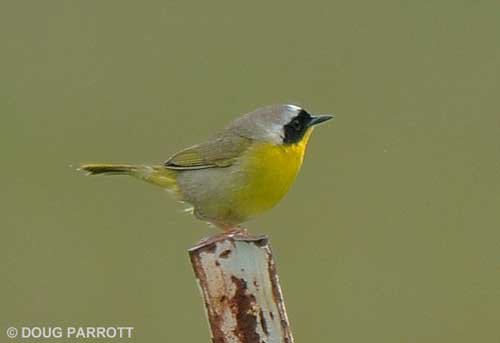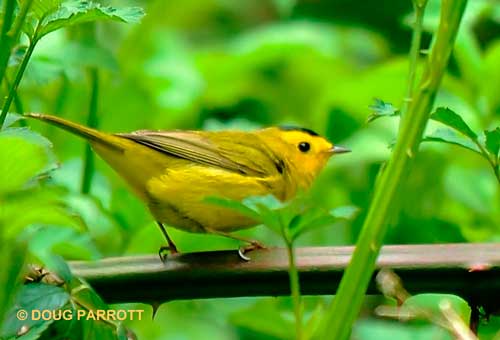I ran into a birder the other day who was standing near Kern’s Restoration Pond, looking frustrated. “What’s up?” I asked, prepared to hear a dog-off-its-leash story, or something similar.
“I can hear a Common Yellowthroat in there singing, but darned if I can find him,” complained the birder.
I know the feeling. Common Yellowthroat males are among the most beautiful of all our summer warblers. They have sun-bright yellow fronts and a dramatic black mask across their eyes. Imagine a combination of Liberace and Zorro, only downsized to something not much bigger than a golf ball, and you’ll get the picture.
You would think a Common Yellowthroat would be easy to see in this get-up, but the opposite is true. A male can sing literally inches away and yet remain completely hidden. When he finally does move, you realize you’ve been staring in the correct vicinity but have somehow missed the bird.
“Well,” I said, trying to console the birder, “we’re not dolphins, you know. We can’t echo-locate,” and I gave a little ping.
The birder gave me “the Look” and then harrumphed off. Reflecting on the fact that I had always previously thought only women were capable of executing the Look, I sat down on my camp stool and prepared to wait for the Yellowthroat to sing again. Shortly, he did but remained hidden. I scanned the habitat. The bird appeared to be in a patch of leafy bushes that measured only a hundred cubic feet or so, but it was simply impossible to find him.
Then I remembered owls. Owls can’t echo-locate like dophins either. In other words, they can’t bounce a ping off a body the way sonar does and then listen for the return echo. Nevertheless, they can locate prey by sound. They can do it because their ears are asymmetrically positioned on their heads. One ear is higher than another, enabling owls to tell where a sound source such as a scuttling mouse is, based on differences in intensity of sound reaching each ear.
How hard can that be? I wondered. I cupped one hand behind my left ear and tilted my head to the right, maximizing the sound differential. The warbler warbled, and I strained to tell apart the intensities of sound coming to my enhanced ear versus my unadorned ear. “Eh?” I said, just as a jogger ran past.
“I didn’t say anything,” she said, giving me a different kind of Look. Then she saw that I had been talking to the bushes, and she backed away slowly, keeping me in view. When she judged she had gotten far enough away from the crazy lady who apparently thinks plants have brains, she turned and passed from my life.
Meanwhile, a flash of yellow informed me the Common Yellowthroat had also passed from my life. “Thanks a lot,” I told his departing form, and so to home. Once again, the Bird Lady had added to her reputation.



